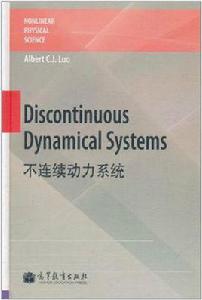內容簡介
書中介紹的不連續動力系統中的障礙向量場理論將徹底改變人們在動力學系統中傳統的思維方式;棱上動力學及其流轉換複雜性理論是人們討論動力學系統的低維網路通道吸引的數學基礎;具有多值向量場的流對其邊界、棱和頂點的跳躍流理論給小廠動力系統網路的“檯球”理論的數學基礎;動力系統的相互作用理論是動力系統網路中的普適性原理,並套用於動力系統同步。
《不連續動力系統(英文版)》可作為套用數學、物理、力學及控制領域的大學師生及科研人員的參考書。
作者簡介
羅朝俊,博士,美國南伊利諾伊大學教授,非線性動力學及力學領域的國際知名學者和專家。
圖書目錄
chapter 1 introduction
1.1. a brief history
1.2. book layout
references
chapter 2 introduction to flow passability
2.1. domain accessibility
2.2. discontinuous dynamical systems
2.3. flow passability
2.4. grazing flows
2.5. switching bifurcations of passable flows
2.6. switching bifurcations of non-passable flows
2.7. an application: a frictional oscillator
2.7.1. grazing phenomena
2.7.2. sliding motion
references
chapter 3 singularity and flow passability
3.1. real and imaginary flows
3.2. g-functions and vector field decomposition
3.3. passable flows
3.4. non-passable flows
3.5. grazing flows
3.6. flow switching bifurcations
3.7. first integral quantity increments
3.8. an example
3.8.1. conditions for sliding and grazing
3.8.2. periodic motions
3.9. concluding remarks
references
chapter 4 flow barriers and switchability
4.1. flow barriers for passable flows
4.1.1. coming flow barriers
4.1.2. leaving flow barriers
4.1.3. passable flows with both flow barriers
4.2. flow barriers for sink flows
4.3. flow barriers for source flows
4.3.1 boundary flow barriers
4.3.2. leaving flow barriers
4.4. sink flows with flow barriers
4.5. an application
4.5.1. switchability conditions
4.5.2. illustrations
4.6. concluding remarks
references
chapter 5 transport laws and multi-valued vector fields
5.1. discontinuity classification
5.2. singular sets on boundary
5.3. forbidden boundary and boundary channels
5.3.1. forbidden boundary
5.3.2. boundary channels
5.4. domain and boundary classifications
5.4.1. domain classification
5.4.2. boundary classifications
5.5. transport laws
5.6. multi-valued vector fields and bouncing flows
5.6.1. bouncing flows
5.6.2. extended passable flows
5.7. a controlled piecewise linear system
5.7.1. passable and bouncing conditions
5.7.2. illustrations
references
chapter 6 switchability and attractivity of domain flows
6.1. dynamical systems on edges
6.2. edge classification and mirror domains
6.3. domain flow properties to convex edges
6.4. domain flow switchability to convex edges
6.5. transverse grazing passability to concave edges
6.6. domains flow attractivity
6.6.1. attractivity to boundary
6.6.2. attractivity to edge
6.7. multi-valued vector fields switching at edges
6.7.1. bouncing domain flows at edges
6.7.2. extended passable domain flows to edges
references
chapter 7 dynamics and singularity of boundary flows
7.1. boundary flow properties
7.2. boundary flow switchability
7.3. switchability of boundary and domain flows
7.4. boundary flow attractivity
7.5. boundary dynamics with multi-valued vector fields
7.5.1. bouncing boundary flows
7.5.2. extended passable boundary flows
references
chapter 8 edge dynamics and switching complexity
8.1. edge flows
8.2. edge flow switchability
8.3. edge flow attractivity
8.4. edge dynamics with multi-valued vector fields
8.4.1. bouncing edge flows
8.4.2. extended passable edge flows
8.5. a frictional oscillator with two-degrees of freedom
8.5.1. domains, edges and vector fields
8.5.2. analytical conditions
8.5.3. mapping structures and numerical illustrations
references
chapter 9 dynamical system interactions
9.1. introduction to system interactions
9.1.1. system interactions
9.1.2. discontinuous description
9.1.3. resultant dynamical systems
9.2. fundamental interactions
9.3. interactions with singularity
9.4. interactions at edges
9.5. application to system synchronization
9.5 1. discontinuous description
9.5.2. flow switchability on boundaries
9.5.3. synchronization invariant sets and mechanism
9.5.4. illustrations for synchronization
references
subject index

